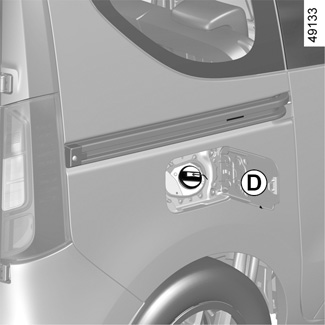FUEL TANK

Petrol and diesel versions
Usable capacity of the fuel tank: 50 litres approximately.
To open the fuel flap B, place your finger in the recess C.
On some vehicles, the cap 1 can be unlocked with the ignition key. If not, unscrew the fuel filler cap, it is connected to the vehicle by a strip of plastic.
Use the cap holder 2 on the flap B during filling to hold the cap 1 in place.
For details on filling the fuel tank, refer to the information on “Filling with fuel”.
To close it, press the cover B with your hand, as far as it will go.
Depending on the vehicle, the hook A prevents the sliding side door from opening fully.
After filling, check that the cap and cover are closed.
To fill up with fuel, the engine must be stopped (and not only on standby in the case of vehicles equipped with the STOP and START function): you must switch off the ignition STARTING, STOPPING THE ENGINE.
Fire hazard.
Fuel filler cap: this is a specific type.
If you have to replace it, make sure it is identical to the original cap. Contact an approved Dealer.
Never place the cap near a source of heat or flame.
Do not wash the filler area with a high-pressure washer.

Fuel grade
Use a high-grade fuel that complies with the legislation in force in each country. It must comply with the specifications given on the label D on the inside of the flap. ENGINE SPECIFICATIONS.
Petrol versions
It is essential to use unleaded petrol. The octane rating (RON) must conform to the information given on the label D on the inside of the flap ENGINE SPECIFICATIONS.
Diesel versions
It is essential to use diesel that conforms to the information given on the label D on the inside of the flap ENGINE SPECIFICATIONS.
Fuel types that conform to European standards with which the engines of vehicles sold in Europe are compatible: refer to the table ENGINE SPECIFICATIONS.
Do not mix even small amounts of petrol (unleaded or E85) with diesel.
Do not use ethanol-based fuel if your vehicle is not compatible with this fuel.
Do not add reagent to the fuel - otherwise you risk damaging the engine.
If you wish to add an additive to the fuel, use a product approved by our Technical Department.
Consult an approved dealer.
Filling with fuel
With the ignition off, insert the nozzle to open the valve and insert it fully before turning it on to fill the fuel tank (risk of splashing).
Keep the nozzle in this position throughout the entire filling operation. When the pump cuts out automatically at the end of the filling procedure, a maximum of two further filling attempts may be made, as there must be sufficient space in the fuel tank to allow for expansion.
Make sure that no water enters the fuel tank during filling. The valve and its surround must remain clean.
Petrol versions
Using leaded petrol will damage the antipollution system and may lead to a loss of warranty.
To ensure that the fuel tank is not filled with leaded petrol, the fuel tank filler neck contains a restrictor fitted with a foolproof system which only allows the nozzle for unleaded petrol to be used (at the pump).
Special case
When the vehicle has been stopped for around three months, you must add fuel to prevent damage to the fuel pump.
To do this, with the ignition off, top-up at least 1.10 gallons (5 litres) then start the engine to operate the pump and renew the fuel in the circuit.
If it is not possible to add at least 1.10 gallons (5 litres) of fuel due to the fuel level in the tank, drive the vehicle until the tank has capacity.
Persistent fuel odour
If you notice a persistent fuel odour you should:
- stop the vehicle as soon as traffic conditions allow and switch off the ignition;
- switch on the hazard warning lights and ask your passengers to leave the vehicle and stay clear of the traffic;
- contact an approved Dealer.
Running out of fuel on Diesel versions
Set the ignition key to “On” position C RUNNING IN, IGNITION SWITCH and wait a few minutes before starting in order to enable the fuel circuit to be primed.
If the engine does not start, repeat the procedure.
If the engine does not start after several attempts, please contact an authorised dealer.
Please note when working close to the engine that it may be hot. The engine cooling fan may also start at any moment. The label in the engine compartment reminds you of this.
Risk of injury.
No modifications whatsoever are permitted on any part of the fuel supply system (electronic units, wiring, fuel circuit, injectors, protective covers, etc.) as this may be dangerous (unless undertaken by qualified Network personnel).